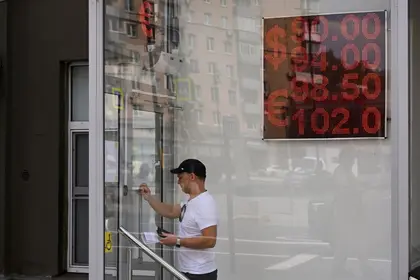History was made on Thursday as the Russian ruble reached a new historic low in value against the US dollar and the euro.
Since 1991, with the exception of roughly one month immediately following Russia’s full-scale invasion of Ukraine, the ruble has never performed as poorly as RUB 90 to the dollar or greater than RUB 100 to the euro.
JOIN US ON TELEGRAM
Follow our coverage of the war on the @Kyivpost_official.
Moscow's exchanges on Thursday closed at RUB 92.3 to the dollar and RUB 99.8 to the euro, having earlier in the day exceeded 93 and 101 respectively.
Professor Dennis Novy of the University of Warwick told Kyiv Post that the West erred in its initial sanctions, evidenced by the fact that the ruble regained its value after the initial invasion. He said this was "because Western countries pushed import sanctions more than export sanctions.”
“That is, imports from Western countries into Russia were curbed while Russia was still initially allowed to export oil and gas to Western Europe,” he added.
However, things have now turned about-face, with Professor Novy pointing out: “The ruble is starting to get weaker” and "since the summer of 2022, the trend has reversed."
He says this is partially due to the fact “Western countries have increasingly made it harder for Russia to export oil and gas.”
Russia has faced increasing economic challenges as the value of gas and oil have significantly declined. This time last year, Brent crude oil was trading for roughly $102 per barrel, whereas today the going rate is $75 per barrel.

Russia Used Social Media to Meddle in 2024’s US Presidential Election
Going forward, for sanctions to have an optimal effect on Russia, Professor Novy asserts that it is important “to curtail both imports and exports.”
“Imports can be used to keep up military equipment and supplies, and export revenue fuels the financing of the war,” he adds. “It is essential for Western countries to prevent trade rerouting through third countries.”
A worrying fact for Russia is that, unlike the 2022 outlier, the decline of the ruble has been a sustained phenomenon that shows no signs of slowing down.
Dr. Oleksandr Lugovskyy, an American economist originally from Ukraine, told Kyiv Post that he expects “a gradual but relentless decline in the standard of living coupled with higher unemployment” in Russia.
He says there is “a general consensus that Russian GDP was negatively affected by the war” but adds that the aggregate growth statistic does not likely show the full negative impact on an average Russian citizen, as “military expenditures offset declines in consumer-centric sectors.”
Though it might be a gradual decline, Lugovskyy says the effects “will be long term and felt by the future generation.”
“The current lack of investment into modernization is compounding quickly and robbing Russia of a future,” he explains. “A perennially weak ruble will preclude Russians from enjoying the comforts they have gotten used to over the last couple decades and slide into poverty.”
This past May, US news reports indicated that Russia was considering buying $200 million of Chinese yuan to “replenish its foreign reserves.”
According to one economist who spoke with Kyiv Post, ruble-holders are likely to worsen as Beijing has signaled that it may not be willing to continue buying rubles as it has its own economic problems, including rising debt, to deal with at home.
Despite the indicators of devaluation, Russian President Vladimir Putin’s regime has announced that government salaries will be increased over the next year, while the printing of money will only make the devaluation more acute.
You can also highlight the text and press Ctrl + Enter






